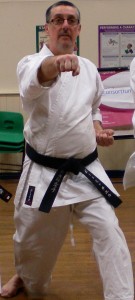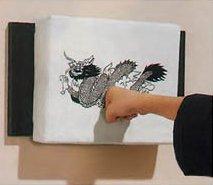One of the most popular and most frequently visited postings that I’ve ever done on this website has been an unbiased look at the differences between Karate and Tae Kwon Do. So I thought I’d do the same between Karate and Kung Fu.
As with Karate and Tae Kwon Do, I believe that there is often a lot of misunderstanding between Karate and Kung Fu practitioners as they don’t really understand what the other one is doing or why! That said, there are many people who cross train between the 2 styles, in particular Karateka who train in Kung Fu to better understand the roots of the their own system.
This post is not aimed at arguing that either martial art is better than the other, as I have always maintained, there is no “best style” only a “best style for a given individual”.
But to tackle a question like this is a massive subject as there are hundreds of styles of Karate and thousands of styles of Kung Fu; so I am going to have to lay down some parameters before I start.
Firstly from the Karate perspective; most modern styles trace back to the two Okinawan styles of Naha Te and Shuri Te. There is arguably also Tomari Te, but that is really a branch of Shuri Te. To confuse the issue further, many modern styles are also a hybrid of the two (like Shitoryu).
Naha Te (which later became Goju Ryu) was almost completely based on White Crane and Praying Mantis Kung Fu, whilst Shuri Te was quite extensively modified by the Okinawans. So for the purpose of this posting, I’ll be looking at the Karate styles from the Shuri Te/Shotokan lineage. Ironically, much of this will apply to Tae Kwon Do as well, despite significant development by the Koreans.
Kung Fu is even more difficult due to it’s huge variety. So for the purpose of this posting, I’ll be looking at the traditional Shaolin styles of Kung Fu (rather than modern Wu Shu, Wing Chun or the Daoist based internal arts).
Usually one of the first things that people say when comparing Karate and Kung Fu is that Karate is more linear and that Kung Fu is more circular. But what does that actually mean in application?
If you look at a Karate reverse punch, the hips are rotated, yet the arm goes out straight; so there is a combination of circular and linear movements within the same technique. Many (if not most) Karate techniques are powered by a hip rotation, so does that make them partly circular. Furthermore, although Kung Fu tends to have more techniques where the arms attack in a circular fashion, they also have a lot of techniques that come out straight forward, so are they linear?
Basically, what defines a linear or circular technique is not just whether the body rotates or not, or even if the attacking hand/foot moves in a straight or circular motion. It is how the technique is powered. A linear technique is powered by the forward inertia and momentum of the body, whilst circular technique is powered by the centrifugal force created by a rapid rotation which does not necessarily move the body forward.
You can see this more clearly in the 2 videos below. In the first one you see a Karate reverse punch. The hips rotate from being pulled back approximately 45 degrees to being rotated square to the front. But overall the body weight moves forward in the direction of the punch.
In this Kung Fu example, you’ll see that the hips are rotated much further, so much so that the stance is facing at 90 degree’s to the direction of the punch and opponent. When he performs the second punch, his hips rotate almost 180 degrees around to face the other direction (compared with Karate’s 45 degree hip rotation). This obviously creates more centrifugal force. The technique will vary from style to style, but it does demonstrate the general principle. However, it does not create any forward momentum towards the opponent.
Again, I do not suggest that either method is superior to the other, they are just 2 modified ways of achieving the same result, which is putting down some b*****d who seriously deserves it. It should also be made clear that Karate and Kung Fu both contain linear techniques and they both contain circular techniques. It is just that Karate puts more emphasis on linear whilst Kung Fu puts more emphasis on circular.
Some people say that Karate is more aggressive. Shuri Te was developed by the bodyguards to the Okinawan king. They were the masters who evolved linear technique. When you examine their requirements and the challenges that they faced, they needed a system of taking the fight quickly and ruthlessly to their enemies. To do this you need to be able to move forward (linear).
With a circular system, to a certain extent you are letting the other guy bring the fight to you. That may not have been an option for the Shuri bodyguards, but for us today who should only be interested in self defence, it is fine. You can still take the initiative and give a pre-emptive strike if somebody comes too close (which an aggressor will do) but you don’t need to take the fight to him.
Circular technique is better for grappling, spinning very fast when you have hold of somebody is a good way to of-balance or throw them. It also helps to apply locks to any trapped limbs very quickly.
Linear technique is less versatile in application, but was designed for very much with multiple assailants in mind where running away was not an option (as in bodyguards). For this they needed to take the fight to the opponent, put him down very quickly, then move onto the next. I believe that this is where the Japanese maxim of Ikken Hissatsu (one strike, one kill) comes from. Grappling techniques are too slow when you’re outnumbered, so that versatility was not required.

Many of the Shaolin styles are based on animal movements such as Tiger, Snake, Monkey, Praying Mantis, Crane and many others (even mythical creatures such as the Dragon). Although these styles imitate animal movements, they are still very effective in application. Drawing from the movements of mammals, birds, reptiles and even insects has led to a great deal of innovation and inspiration, not only in fighting techniques, but in the principles adopted (for example, power from the Tiger, but flexibility from the Snake).
Karate however has been more influenced by the Zen philosophy which is (or was) very popular in Japan. Part of Zen is to minimize everything, which has also been applied to the movements in martial arts. Only the movements strictly required for a technique are included, all else is striped out giving it a much plainer appearance in many ways. This also fits in with the linear concept of less emphasis on grappling and versatility, but focusing more on multiple opponents instead.
Of course this is a very broad subject as already mentioned and there is a lot of overlap between Karate and Kung Fu, so this posting can only be a guide rather than a definitive in every case and every application. As such there will be plenty of exceptions, so any writing on this subject (by me or anybody else) should only be regarded as a generalised guide.
If you have found this useful, or if you have anything to add to the subject, then please leave your comments below.



 Karate Depot have asked me to review a makiwara (striking board) for them. But first, I would like to talk about what makawara training is actually trying to achieve as it not quite what most people imagine.
Karate Depot have asked me to review a makiwara (striking board) for them. But first, I would like to talk about what makawara training is actually trying to achieve as it not quite what most people imagine.